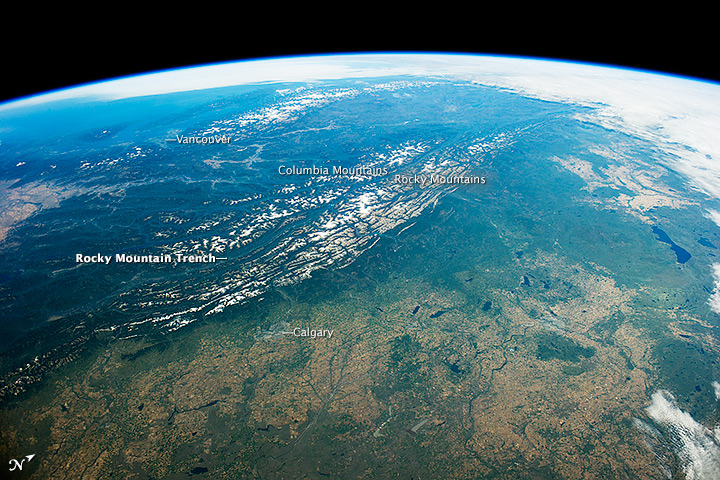Image: Rocky Mountain Trench from ISS
Description: In western Canada, rumor has it that the Rocky Mountain Trench is so large that it is visible from the Moon. The story goes that one of the Apollo astronauts in lunar orbit radioed back to Mission Control to ask about the straight line he saw cutting across northwestern North America. “It turns out that is not even remotely true,” said Ben Gadd, a naturalist and author of the Handbook of the Canadian Rockies. When NASA historians checked all of the Apollo transcripts for references to a feature like the Rocky Mountain Trench, they found nothing. The Moon is so far from Earth (363,000 kilometers or 226,000 miles) that it is not possible to distinguish such a feature with the naked eye. Astronauts can, however, see the Rocky Mountain Trench quite clearly from the International Space Station (ISS), which maintains an orbit about 400 kilometers (250 miles) above the surface of Earth. This photograph was taken by an astronaut on September 6, 2014. The trench, with a width that ranges from about 3 to 16 kilometers (2 to 10 miles), separates the Columbia Mountains on the west and the Canadian Rockies on the east. (Note that the image has been rotated so that north is to the right.) Exposed rock appears gray; forests are green; grain fields are yellow; snow-capped mountains are white. While geologists still debate the circumstances that created the trench, the section seen here likely formed due to underlying normal faults that emerged in the aftermath of tectonic collisions that pushed up the mountains. Normal faults are ruptures in the rocky outer part of Earth—the lithosphere—that generally emerge when land surfaces get stretched out. In a normal fault, one piece of lithosphere drops down relative to another. In this case, the normal faults that underlie the southern half of the Rocky Mountain Trench likely formed as the lithosphere stretched after a period of mountain building that occurred between 185 million and 55 million years ago. At least three chains of islands plowed into the western coast of North America, forming mountains by bulldozing rock layers onto North America. In this part of western Canada, mountain building progressed from southwest to northeast, so the Columbia Mountains are older than the Canadian Rockies. With the normal faults in place, rivers and glaciers have since worked to widen and deepen the trench through erosion. “Along the section of the trench seen in the photo, there has been little or no San-Andreas-style horizontal slippage. The rock on either side has moved mainly up on the northeast side and down on the southwest side,” explained Gadd. “But in the northern part of the trench (not visible) there is a magnificent transcurrent fault, in which the land on the southwest side has moved at least 400 kilometers toward the northwest, and perhaps as much as 900 kilometers.”
Title: Rocky Mountain Trench from ISS
Credit: http://earthobservatory.nasa.gov/IOTD/view.php?id=84881&src=eoa-iotd
Author: ISS Crew Earth Observations
Permission: Public domainPublic domainfalsefalse This file is in the public domain in the United States because it was solely created by NASA. NASA copyright policy states that "NASA material is not protected by copyright unless noted". (See Template:PD-USGov, NASA copyright policy page or JPL Image Use Policy.) Warnings: Use of NASA logos, insignia and emblems is restricted per U.S. law 14 CFR 1221. The NASA website hosts a large number of images from the Soviet/Russian space agency, and other non-American space agencies. These are not necessarily in the public domain. Materials based on Hubble Space Telescope data may be copyrighted if they are not explicitly produced by the STScI.[1] See also Template:PD-Hubble and Template:Cc-Hubble. The SOHO (ESA & NASA) joint project implies that all materials created by its probe are copyrighted and require permission for commercial non-educational use. [2] Images featured on the Astronomy Picture of the Day (APOD) web site may be copyrighted. [3] The National Space Science Data Center (NSSDC) site has been known to host copyrighted content. Its photo gallery FAQ states that all of the images in the photo gallery are in the public domain "Unless otherwise noted."
Usage Terms: Public domain
License: Public domain
Attribution Required?: No
Image usage
The following page links to this image:


